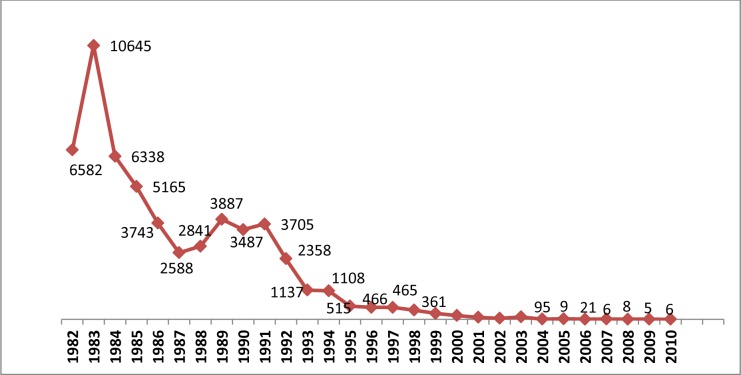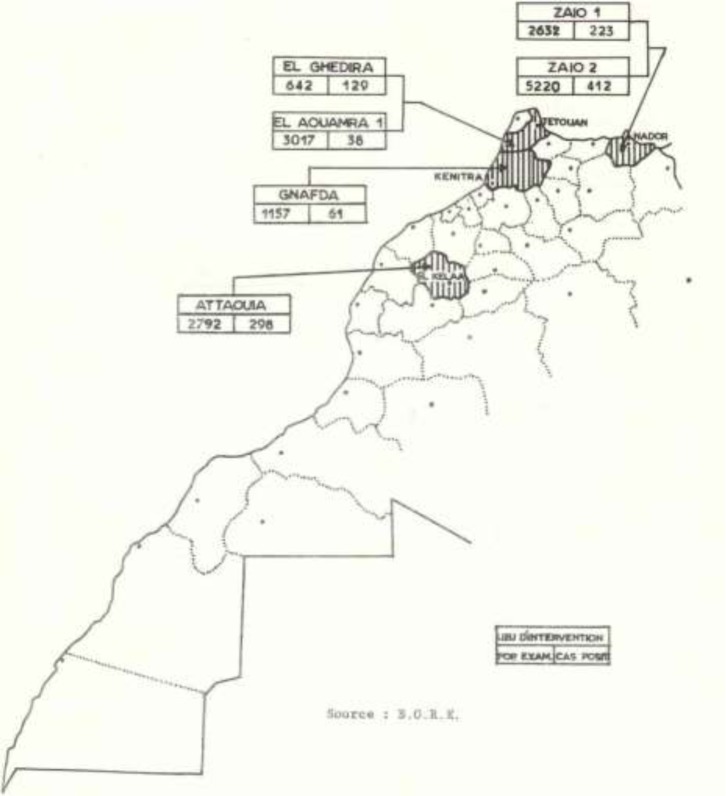Abstract
Since it was first diagnosed in 1914 in Marrakesh, schistosomiasis has been a public health problem in Morocco for decades. A national control program launched in 1982 has led to a considerable reduction in the incidence and morbidity associated with the disease. Consequently, the program has shifted from disease control to an elimination process launched in 1994. This process aimed to eliminate disease transmission by the end of 2004 and has helped to clear all known foci. Mobile teams were a key element that contributed to the success of this program. They played three important roles: monitoring and control, response, and the transmission of messages.
Keywords: Mobile team, Schistosomiasis elimination, Morocco, National schistosomiasis
Introduction
Policies for basic health care in Morocco have relied, in addition to the fixed mode of care provided by health centers and dispensaries, on mobile interventions established to provide services at home or nearby (1). This mobile mode consisted of door-to-door visits or visits by a nurse (an “itinerant nurse” traveling with a moped). The point of contact with the nurse was thus either the home or another particular location people identified as a convenient meeting place (2). The third element of this advanced strategy is the mobile unit, consisting of a mobile team with a vehicle as a means of transport.
The Moroccan model of mobile teams is an integrated model in the health system. A mobile team in the true sense of the term includes medical and paramedical staffs that usually travel from the chief town in the district according to an established schedule to ensure regular benefits in areas with little or no access to basic health facilities (3). These mobile teams provide curative care and also, especially, preventive care including immunization, maternal and child healthcare, disease screening, etc. From this perspective, mobile units are a routine extension of fixed health centers (3).
Regarding schistosomiasis, in the WHO Eastern Mediterranean Region there are two main epidemiological patterns of the disease. The first is represented by a group of countries that still have high endemicity (Somalia, Sudan and Yemen), and the second consists of a group of countries that have low endemicity or have achieved the elimination of the disease (Saudi Arabia, Egypt, Libyan Arab Jamahiriya, Morocco, Oman, the Syrian Arab Republic, Tunisia).
In this region the Kingdom of Morocco, where the disease has been present for decades, is one of the few countries to have developed, implemented and managed a process to eliminate the disease process. Indeed, since 2004 schistosomiasis has been considered to be eliminated in this country, and the 1994 goal of eliminating disease transmission has thus been achieved.
Since the program’s launch, the control strategy was based on three basic principles, namely:
health education of target populations;
the fight for parasite screening activities (selective and mass screening) and case processing;
The fight against the intermediate snail host (Bulinus truncatus) by physical and chemical actions (use of Bayluscide).
This strategy has helped minimize the number of cases since 2004; cases detected since then are considered residual or imported (Fig. 1).
Fig. 1.
Evolution of cases of Schistosomiasis, Morocco 1982 - 2010
This success is largely due to the contribution of mobile teams, which have been used to conduct screening campaigns and provide mass treatment. Their contribution to efforts to eliminate schistosomiasis is unequivocal. Thus, they played three important roles: surveillance and control, response, and transmitting messages through information, health education and communication activities.
This study aimed to highlight the importance of the activities carried out by mobile teams, sets out to document the beneficial impact of mobile teams, and draws conclusions that could potentially be applied to other control programs.
Materials and Methods
This study is based mainly on a met analysis of research on schistosomiasis in Morocco, as well as reports and the publications of the Ministry of Health. The summary of this study attempts to describe the role of mobile teams in activities against schistosomiasis.
Composition of mobile teams
The mobile team is regarded as an extension of fixed healthcare structures, and consists of at least three officers including a doctor. It travels periodically with a vehicle and covers its assigned route at least once per trimester). It is intended to cover areas further than 6 km away, or less than 6 km if the terrain is difficult, the population density is high, or if there are health problems requiring intervention nearby.
Contribution of mobile teams to activities for Schistosomiasis control
A-Surveillance and control role
The mobile teams, as part of their screening and treatment activities for Schistosomiasis, regularly traveled the roads and tracks of villages where this disease was reported. This aspect of their role can be divided into four main stages (4):
-
–
First stage: From the early 1970s on the eve of the integration of the national control program.
-
–
Second stage: Control program from 1982 to 1993
-
–
Third stage: Elimination of the disease between 1994 and 2004
-
–
Fourth stage: Consolidation since 2005.
The first stage
This stage concentrated on the detection and containment of foci of disease transmission, and was carried out almost exclusively by mobile teams for screening activities or malacological surveys.
a-Screening activities
In 1978, an initial test mass screening for mass chemotherapy was conducted at the locality Gnafda in the province of Kenitra. In 1979, more organized operational tests were done by the mobile teams at foci of schistosomiasis transmission on different scales, in the provinces of Nador, El Kelaa and Tetouan (Fig. 2 and Fig. 3). (5)
Fig. 2.
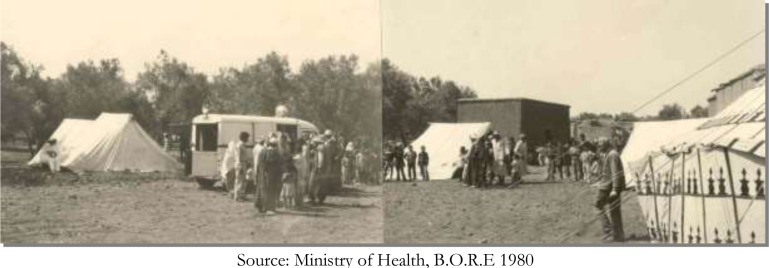
Mass screening in the Attaouia Sector, Province of El Kelaa Sraghnas, Morocco, September 1979 Data collection for screening was not effective until 1980.
Fig. 3.
Zones of mass chemotherapy intervention, Morocco 1978–1979
During the years 1980 and 1981, a total of 134,833 urine samples were examined, including 37,160 by selective screening (27.6%) and 97,673 by mass screening and intensive screening (72.4%) (Table 1) (5).
Table 1.
Evolution of urine samples examined and positive results detected according to type of screening, Morocco, 1980–1981
| Selective screening | Mass screening | Intensive screening | Total | |||||
|---|---|---|---|---|---|---|---|---|
| Number | Urine + | Number | Urine + | Number | Urine + | Number | Urine + | |
| 1980 | 11310 | 2893 | 20146 | 3861 | 0 | • | 31456 | 6754 |
| 1981 | 25850 | 2948 | 9077 | 142 | 68450 | 6536 | 103377 | 9626 |
| Total | 37160 | 5841 | 29223 | 4003 | 68450 | 6536 | 134833 | 16380 |
Sources: Annuals Reports of the National Program against Schistosomiasis, Ministry of Health
The number of cases detected during this period was 16,380, of which 64% (10,539 cases) were detected by mobile teams.
b-Malacologicalprospections
During this step, efforts focused on delimiting the range of the intermediate host, identifying the factors that affect its behavior, the development of prospecting techniques and the organization of malacological monitoring in terms of frequency of surveys, identification of the intermediate host and tests of cercarial emission (6).
Thus, a circuit of malacological prospection conducted by mobile teams was established (Fig. 4) and provinces were selected on the basis of the existence of foci of disease transmission or the existence of irrigated areas where there were no foci of transmission, but where a potential danger existed (5).
Fig. 4.
Circuits of malacological prospection, Morocco 1979. Source: B.O.R.E
Stage of active intervention of the Program
The active intervention stage aimed to set up operations to fight the disease (with screening, chemotherapy and molluscicide) through separate or combined measures. Mass screening concerned schools and localities where the positivity rate exceeded 4% (6).
A total of 1,787,638 urine samples were examined, of which 66% were obtained from mass screening. Of all cases detected, 64% (33, 376) were identified by mass screening carried out by mobile teams (Table 2).
Table 2.
Evolution of urine samples examined and positive results detected according to type of screening, Morocco, 1982–1993
| Selective screening | Mass screening | Total | ||||
|---|---|---|---|---|---|---|
| Urine samples examined | Cases | Urine samples examined | Cases | Urine samples examined | Cases | |
| 1982 | 55604 | 2880 | 4493 | 3702 | 100541 | 6582 |
| 1983 | 43264 | 3146 | 9338 | 7507 | 136644 | 10653 |
| 1984 | 54373 | 2879 | 8706 | 3463 | 141442 | 6342 |
| 1985 | 60711 | 2567 | 8624 | 2598 | 146960 | 5165 |
| 1986 | 63609 | 2161 | 7498 | 1582 | 138597 | 3743 |
| 1987 | 50646 | 1259 | 5814 | 1329 | 108786 | 2588 |
| 1988 | 64948 | 1146 | 9039 | 1695 | 155340 | 2841 |
| 1989 | 65136 | 956 | 1094 | 2931 | 174274 | 3887 |
| 1990 | 61438 | 804 | 9067 | 2683 | 152115 | 3487 |
| 1991 | 45153 | 599 | 1421 | 3106 | 187344 | 3705 |
| 1992 | 36955 | 378 | 1431 | 1980 | 180082 | 2358 |
| 1993 | 37980 | 337 | 1275 | 800 | 165513 | 1137 |
| Total | 639817 | 19112 | 1148 | 33376 | 1787638 | 52488 |
Sources: Annuals Reports of the National Program against Schistosomiasis, Ministry of Health.
Process of Schistosomiasis Elimination: 1994–2004
The process of schistosomiasis elimination was launched in 1994, after awareness of all partners had been ensured and all had received information, under the slogan “Schistosomiasis is a manageable problem, let’s work together to eliminate it from our beautiful country” (7). This step was characterized by systematic annual mass campaigns at all exposed localities (Fig. 5).
Fig. 5.
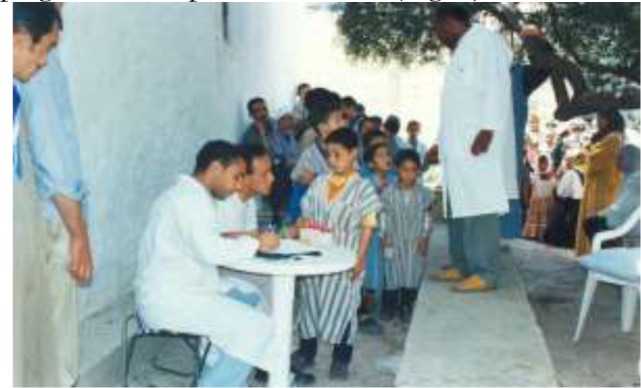
Mass screening in the province of Chtouka Ait Baha, 2002)
This mass screening intervention can be repeated during the year if the epidemiological situation requires it. It can be carried out both at schools and exposed localities.
During the period from 1994 to 2004, a total of 1,733,974 urine samples were examined, of which 1,453,209 (84%) were tested by mass screening (Fig. 6).
Fig. 6.
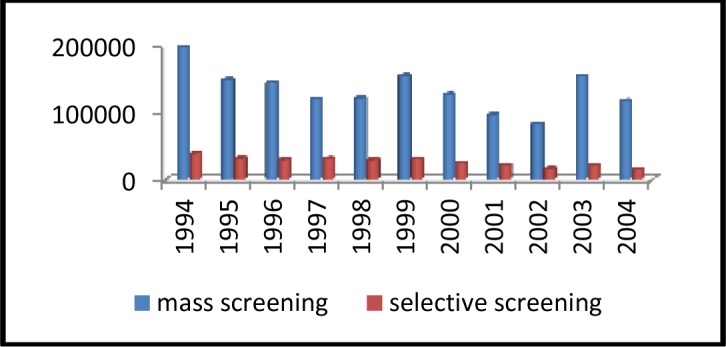
Evolution of urine samples examined during the schistosomiasis elimination stage, Morocco 1994–2004/Source: Annuals Reports of the National Program against Schistosomiasis, Ministry of Health
Among the 3521 cases reported during this period, 2701 cases (77%) were detected by mobile teams during mass screening (Fig. 7).
Fig. 7.
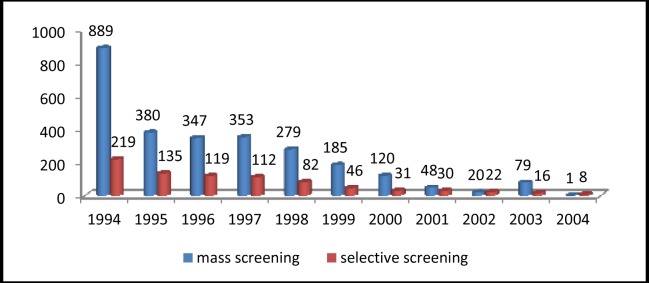
Distribution of schistosomiasis cases detected according to type of screening during the schistosomiasis elimination stage, Morocco, 1994–2004/Source: Annuals Reports of the National Program against Schistosomiasis, Ministry of Health
Consolidation of elimination stage: 2005–2010
Since 2005, the program entered a consolidation stage designed to stop disease transmission under the slogan “Be vigilant in order to consolidate our gains.” During this stage, surveillance and control activities continued as before, but with a rapid reporting system for any new cases detected, in order to carry out, if necessary, urgent response actions (4). An annual average of 89,634 urine samples were examined during this period of consolidation, including 13% by selective screening and 87% by mass screening done by mobile teams. (Fig. 8)
Fig. 8.

Distribution of urine samples examined during the consolidation stage, Morocco 1994–2004/Sources: Annuals Reports of the National Program against schistosomiasis, Ministry of Health.
The number of cases recorded during this period totaled 35, with 30 cases (86%) detected during selective screening and 5 cases (14%) detected during mass screening. These low numbers are explained by the fact that all cases were either residual or imported.
We can conclude that mobile teams contributed significantly and effectively to schistosomiasis surveillance and disease control. Two features of their work were especially noteworthy:
-
–
Almost all epidemiological investigation was done by the mobile teams;
-
–
They also carried out regular interventions against the intermediate host;
-
–
Most importantly, three quarters of all cases diagnosed since 1982 were detected by mass screening carried out by the mobile teams.
B-Role of response
Responsiveness is a strategic doctrine adopted by the program to attempt to resolve or ameliorate a situation that is not clear, to upgrade the performance of screening activities or to neutralize all transmission foci that might re-emerge. Thus, the mobile teams intervened to upgrade screening interventions especially in 1983, 1994 and 1999, and their effectiveness surpassed expectations.
The most recent example is work done at the Tata focus in early 2004, where practically all people exposed at the last transmission focus were treated with praziquantel. The goal was to eliminate this focus of transmission, which reactivated in late 2003.
Indeed, in 2003 the province of Tata notified 75 cases of schistosomiasis (compared to only 6 cases in 2002) (8), all located in the area of Akka, particularly at the locality of Rahala (Fig. 9).
Fig. 9.

View of foci from the locality of Rahala (Akka district, province of Tata)
C-Role of awareness-raising and mobilization
For the National Program against Schistosomiasis, IEC was a pivotal and important aspect of its effectiveness.
In all actions undertaken since the beginning of the program, IEC activities were a key factor in achieving the planned objectives. The information and awareness sessions were carried out intensively. Credit is also due to the campaigns organized by the mobile teams with the same reason as part of their screening and mass treatment campaigns. Popular songs, audio and video messages, the enthusiastic cooperation hospitality at the intervention sites, together, usually made the work of the mobile team a cultural event. The success of these events is primarily due to the fact that everybody felt motivated.
Contacts with the people served not only to disseminate information about the disease, but led consistently to a holistic understanding of the problem and reinforced sustained improvements in the involvement of the population. This involvement was manifested not solely by the warm welcome given to the health team when they arrived at each village, but also by the people’s hospitality. (Fig. 10)
Fig. 10.
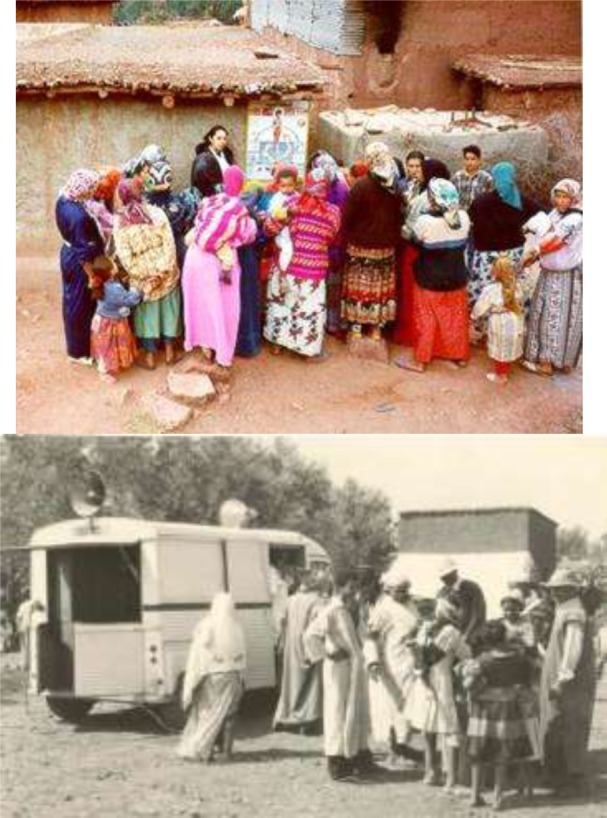
Briefing for the benefit of the population: 1992 (left) and 1979 (right)
Conclusion
Although Morocco suffered during a whole century or more from schistosomiasis, sometimes in its most acute urinary tract manifestation, the control program against this disease was definitely an effective and efficient tool and the results it achieved are conclusive.
These results were of course obtained by the interaction of several factors, but the most determining factor was probably the intensive involvement of mobile units in preventive and disease control activities. These units, despite the episodic nature of their interventions, have played a primordial role in the elimination of schistosomiasis in Morocco. They are expensive and require considerable human resources, and remain indispensable particularly if the aim is to eliminate the disease.
Ethical considerations
Ethical issues (Including plagiarism, Informed Consent, misconduct, data fabrication and/or falsification, double publication and/or submission, redundancy, etc.) have been completely observed by the authors.
Acknowledgements
We thank K. Shashok (Author AID in the Eastern Mediterranean) for improving the use of English in the manuscript. The authors declare that there is no conflict of interests.
References
- Ministry of Health, Department of Population (2009). Rural health plan. Kingdom of Morocco. [Google Scholar]
- Elamri Nasrine (Juillet 2010). Contribution of the mobile team in health coverage, Case Health Unit TAHLA - Province of Taza. Dissertation study. Cycle Masters in Health Administration and Public Health. National Institute of Health Administration Morocco. [Google Scholar]
- Ministry of Health (June 2009). Ministerial Circular No. 13400 on the revitalization of activities accompanied datasheet mobile team. Kingdom of Morocco. [Google Scholar]
- Barkia H, Barkia A, Nhammi H, Belghyti D (2011). Schistosomiasis in Morocco: from discovery to after elimination. Health J East Mediterr, Vol. 17, No. 3 250–256. [PubMed] [Google Scholar]
- Ministry of Public Health (1980): Bulletin of Public Health, 57 N. Rabat, 156P. [Google Scholar]
- Department of Public Health (1982): Guide to control of schistosomiasis, Technical Affairs Directorate, Morocco, 207p. [Google Scholar]
- Ministry of Health, Project for schistosomiasis elimination process in Morocco, paper presented at the consensus meeting chaired by the Minister of Health, Rabat, 1993. [Google Scholar]
- Ministry of Health, Series reports on the status of programs against parasitic diseases, Rabat, 1982–2010. [Google Scholar]



